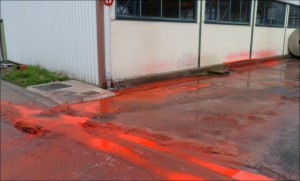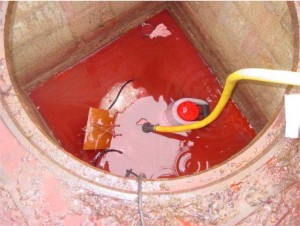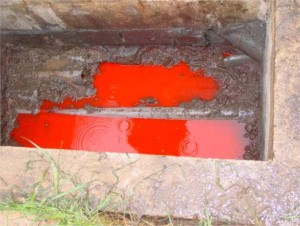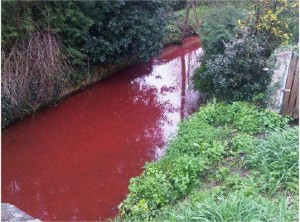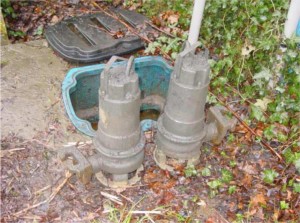Around 1 pm on an outdoor loading/unloading zone at a plant producing paints, inks and varnishes, a technician was shifting some empty mobile tanks with a lifting vehicle when he inadvertently struck the manual quarter-turn valve. This valve had prevented the gravity drainage of a 1,000-litre bulk container still holding 500 litres of a substandard red, water-repellent acrylic paint. Since the container other backflow prevention device being a plug was uninstalled, paint spilled onto the floor. 1 hour lapsed before the technician noticed. In response, he closed the barrel tap and spread sand to absorb the spilled product. This spreading operation turned out to be ineffectual due to heavy downpours at the time, and the paint poured out into the site’s “polluted” storm drain network, which was normally connected to a confinement basin. Noticing the reddening of the ORGE River around 2 pm in the vicinity of his facility and further downstream, the plant operator installed mobile pumps to drain the storm networks and quickly assembled plugs by introducing expansive foam and cloth rags at the site’s outfalls. By 3 pm, the Police Force, fire-fighters and water pollution police, alerted by neighbours or visual observations, show up at the site entrance. The reddish pollution was visible as far as 4 km downstream. Police Force sampled some paint remaining in the barrel, which had been placed under seal. At 6 pm, the river’s visual pollution disappeared adjacent to the site, and the pumping operation was over by 9:30 pm. The volumes were evaluated at: 350 litres of spilled paint, 14,000 litres of pumped water, and 50 to 100 litres of paint spilled into the river.
The investigation led by the inspection authorities for classified facilities revealed that the polluted rainwater was indeed being adequately collected by a pipeline and channelled to the lift pumps for routing into a confinement basin. On the day of the accident however, both pumps were undergoing maintenance and the polluted water remained in the underground pipeline running along the river. This line displayed several seal breaches due to land movement and root penetration; 8 underground infiltration points were thus enabling effluent to migrate towards the river from riverbanks bordering the facility.
The operator adopted several measures, namely:
- verification of the presence of a plug on the other large bulk containers;
- camera inspection of the condition of storm drain networks in order to identify and repair leaks;
- purchase of 2 backup lift pumps, as well as inflatable clogging devices and appropriate cleaning kits;
- implementation of several procedures: regular inspection of the site’s storm drain networks, outdoor storage management, and enhanced communication with the outside world in the event of an incident;
- personnel training in the use of new procedures.



